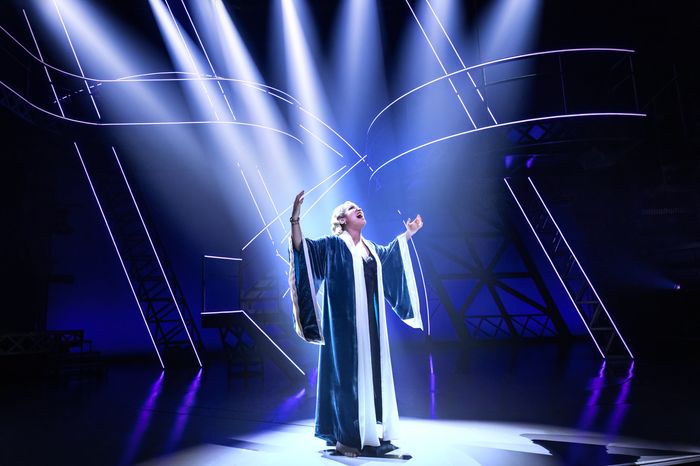
I am politely requesting a moratorium on musicals that begin with some version of “How did I wind up here?” Maybe we’ve all paid a little bit too much attention to Jean-Luc Godard’s most Instagram-quotable epigram: At this point, putting the beginning, middle, and end in that order feels like a vaguely radical act. The irony is that Lempicka—Carson Kreitzer and Matt Gould’s new musical about the tempestuous life of the Polish émigré Art Deco painter Tamara de Lempicka, which begins with the old artist looking world-wearily back—is obsessed with radical acts. It badly wants to be bold, but as any high-school kid can tell you, there’s no surer path to awkwardness than trying too hard. Lempicka the woman was unquestionably fascinating, flawed, and fabulous; Lempicka the musical often goes flat. There’s an uncharacteristically tepid quality to Rachel Chavkin’s direction—as if she’s repeating herself rather than enjoying herself—along with a sense of varnish over the proceedings. We can see the glossy, cool surface, the assertive industrial lines and curves of the painter’s work, but we’re missing its true audaciousness, voluptuousness, and vitality. The show pushes and poses — it doesn’t let us in.
There’s always the risk that a bio-play, even of the most intriguing subject, is going to lack an engine, a reason for being besides walking us through historical events. While that’s not quite the case here, the engine that Kreitzer (book, lyrics, and original concept) and Gould (book and music) have chosen tends to get flooded, either with outpourings of generalized emotion or with preciousness. We’re following the self-creation of an artist and of a woman—from innocent 18-year-old bride to glamorous bisexual art-world superstar—but her big moments of revelation never feel quite as profound as they’re meant to. “Plane, lines, form,” sings Lempicka (Eden Espinosa) in a repeating motif throughout the show. “Plane, color, light.” It’s nuts to throw yourself into such close comparison with Stephen Sondheim; whereas Sunday in the Park With George’s “Color and Light” feels like a musical expression of its own title, full of sparkle and humor woven through its depiction of the creative process, Lempicka’s paeans to art-making drone with self-seriousness. They’re all a little too earnest and evident: “A painting is … plan and design / always design / every minute designed.” Likewise, when the painter first spots her muse, a beautiful prostitute named Rafaela (the radiant Amber Iman, who’s going deep while so much around her stays vapid), Lempicka sings, enraptured: “If I ever see her again, I will speak / ask her name, ask her back to my rooms / she will take off her clothes, lie down, and I will / paint her.” Well, yes.
Gould’s music spends a lot of time swelling, and Espinosa spends a lot of time belting, yet beneath the undulating surface there’s a lack of poetry to Lempicka. Its protagonist is ravished by beauty, sings about it, longs to paint it, but beauty seldom crosses the footlights to pierce us in the heart. Aesthetically, the most striking thing about the production is Riccardo Hernández’s towering set, all angles and stairs and curving metal — part Deco, part Constructivism, part riff on the geometry of the Eiffel Tower. When thin bars of light illuminate its railings, sliding up and down its aggressive lines, it’s genuinely exciting—Harold and the Purple Crayon writ large for the machine age—and when Peter Nigrini’s projections fill the set’s negative spaces with images of Lempicka’s actual paintings, then we get a taste of awe. It’s fleeting, though. Inside Hernández’s imposing architecture, Paloma Young’s costumes seem weirdly half-baked, stuck somewhere between abstract gesture and high glamor; and at the center of the whole apparatus, Espinosa hits the high notes loud, but she remains, as a character, unvaried and opaque. It’s not that Chavkin, Kreitzer, and Gould want to idealize or idolize Lempicka, but they do choose the tritest way of fleshing her out. “Have you ever loved someone, more than life itself?” The painter, age 77, asks us at the start of the show. Politics will swirl violently around Lempicka, but this story will be about love.
If that’s the case, then we’d better buy the potency of these epic love affairs — and only one of them’s got any juice. Lempicka would have us believe that its heroine truly loved both her husband, Tadeusz Lempicki (Andrew Samonsky)—whom she really did rescue after he was imprisoned by the Bolshevik secret police—and her great muse, Rafaela. (We know next to nothing about the real Rafaela, except that, after meeting her, the real Lempicka painted her seven times in the course of one year, and the paintings are indisputably sexy as hell.) Iman brings poise, ease, and emotional heft to Rafaela; her voice is sultry and gorgeous and—as Lempicka gains both fame and shame around her sex-worker girlfriend—Iman’s bitter heartbreak becomes the most affecting thing in the show. (Closely seconded by the wonderful Beth Leavel’s eleventh-hour solo as the Baroness, wife to Nathaniel Stampley’s kindly Baron Kuffner, a patron who will eventually become Lempicka’s second husband.) Samonsky’s Tadeusz can’t compete. He comes off as a clean-cut square (“I don’t want a New Woman / I want / the woman who’s Mine”) and a mope. He doesn’t love the fact that his wife throws herself into work as a painter when they land in Paris as young refugees, but it takes him years of woe-is-me-ing on their sofa before he gets a job himself. When he and Rafaela eventually meet at Lempicka’s first solo show and sing a crisp duet to each other (“I can see what she sees / in you”), we only believe one of them.
Meanwhile, we never get to find out much of what Lempicka thinks of anything but her lovers and her work. Characterizing her as someone whose “real art” was “how to survive,” Kreitzer and Gould seem to be attempting to sidestep a more complex engagement with the questions and compromises of living through both the Russian Revolution and the rise of fascism in Europe — and living through all of this as, if not always someone with money, then certainly an aristocrat by marriage, aspiration, and mindset. It’s especially odd, given the defiant socialist vibes of Hadestown, also directed by Chavkin and still running right across the street from Lempicka, how simplistically “the revolution” is depicted here. Lots of furrowed brows, raised arms, and militant sashaying, while Lempicka, still in ingénue mode, has to offer her virtue to a leering commandant (George Abud) in order to extricate Tadeusz. At least Abud gets to come back later as the founder of Futurism, Filippo Tommaso Marinetti, in what is undoubtedly the show’s most entertaining performance. Marinetti was a nutball in real life: How can you not have a little room for a guy who—even while driving whole-hog into fascism—was so dedicated to writing manifestos that he literally produced a Futurist cookbook, in which he ranted about how pasta makes you “heavy, brutish… skeptical, slow, pessimistic,” and fills you with a “black hole” of “incurable sadness”?
Abud’s Mephistophelean Marinetti quickly becomes—perhaps a bit too transparently in terms of the script—the Che to Lempicka’s Evita. First, as her teacher at the Académie des Beaux-Arts, he gives her her greatest lesson (real, but actually given to her at the Académie Ranson by the artist Maurice Denis): “A painting is not a woman. Or a warhorse. Or a landscape. A painting is a flat surface, covered with paint … We do not control the world. We control one flat rectangle of canvas. At a time.” Then, he leaps out of the stage’s frame to chronicle her rise with the cynical, devilish eye of another 1930s emcee who’s also currently just a few blocks away. “Perfection”—Marinetti’s zealous ode to the glories of “speed / and steel / flame-spitting engine of the automobile”—lets Abud flaunt and revel as if he’s delivering a Futurist “One Night in Bangkok”; and his most Cabaret–esque number, “Pari Will Always Be Pari,” is a wily second-act opener, spiked with nasty irony: “There’s a fire in the Reichstag in Germany / C’est dommage, une tragedie / But that won’t affect us here in Pari.”
Perhaps the real letdown of Lempicka is that, while there are sparks of exuberance in the show, they don’t come from its center. Lempicka herself, here, lacks vibrancy and wit; we never get a real sense of the magnetism that must have encircled her like one of her lavish fur stoles. A painting may rightly be only a canvas covered with paint and a play just a box full of bodies and objects and lights and sounds, but the point is the miraculous depths that can be touched by consciously acknowledging, crafting, and then transcending the artifice. “Who can show me / Something I’ve never seen?” growls Marinetti. Lempicka aspires, even strains, but never quite generates wonder. Art—especially art explicitly about art—isn’t easy.
Lempicka is at the Longacre Theatre.


